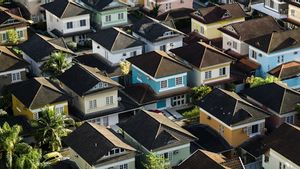JAKARTA - Public transportation-based residential areas or Transit Oriented Development (TOD) are considered a solution for urban arrangements that increasingly have land limitations, such as in Jakarta.
According to property observer Ali Tranghanda, this is because TOD optimizes land functions that are increasingly limited and expensive, with a public transportation base in the region.
In addition, he continued, TOD is currently relevant because it makes the time and activities of people working in the city less wasted on roads due to traffic jams.
"If the city gets bigger, it means that all residents will go to the edge of the buffer zone. Well, the buffer population to Jakarta must have transportation whether MRT, LRT, or trains. When he enters Jakarta he must be connected to TOD nodes that are more complete," he said, quoted from Antara, Friday, September 30.
TOD's vertical draw like that, he added, would be worth taking into account for future investments.
According to the Economy Analyst Sub-Coil, Deputy for Maritime Affairs and Investment, the Indonesian Cabinet Secretariat Mayke Kristika Antony Putri, the complexity of traffic congestion and the high cost that must be incurred due to excess fuel consumption.
This condition requires concrete solutions that can minimize dependence on the use of private vehicles and increase the use of public transportation.
"One solution is to design the construction of an area based on Transit Oriented Development (TOD)," he said as quoted from the setkab.go.id page.
The TOD concept integrates the design of city spaces to unite people, activities, buildings, and public spaces through easy connectivity on foot or cycling and integrates with public transportation throughout the city.
Referring to the Minister of Agrarian Affairs and Spatial Planning/Head of BPN No. 16 of 2017 concerning Guidelines for the Development of Transit-oriented Areas, Mayke said, the concept of the TOD area is a sustainable city design for the community and can be an alternative to urban design for regional economic growth because it combines residential areas with commercial ones.
Mayke said that the development of TOD-oriented cities has the potential to reduce household transportation costs and overcome environmental problems. TOD principles place commercial facilities, settlements, offices, public facilities and social facilities in close distances.
"Several countries in Latin America, Japan, Hong Kong and Singapore have implemented the concept of TOD housing," he said.
The English, Chinese, Japanese, Arabic, and French versions are automatically generated by the AI. So there may still be inaccuracies in translating, please always see Indonesian as our main language. (system supported by DigitalSiber.id)













